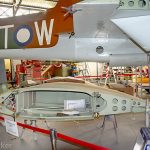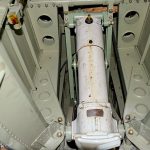
From our good friend John Parker at Warbirds Online comes a recent report on the restoration of Bristol Beaufort A9-141 at the Australian Aviation Heritage Center at Caboolture in Queensland, Australia. The Beaufort was a British torpedo bomber design developed from the Bristol Blenheim just before WWII. Almost two thousand of them were built, with seven hundred or so of them rolling off the production line at the Australian Government’s Department of Aircraft Production (DAP) facility at Fishermans Bend, near Melbourne, Victoria. The type is incredibly rare today, with just a handful of survivors. A9-141 has been under long-term restoration to flying condition for several decades now. It incorporates the remains of several other aircraft, including the rear fuselage of A9-485. A9-141 is a DAP-built example, and began her service with the Royal Australian Air Force on October 29th, 1942. She served in RAAF 14 Squadron, 7 Squadron and Operational Training Units 1 and 5. She came to grief in a ground loop on take off at RAAF Tocumwal on December 1st, 1944, subsequently being relegated to an instructional airframe. A farmer bought the stripped out airframe after the war, which is how the aircraft survived. Her present owner, Ralph Cusack, acquired A9-141 in 1985. We let John Parker take over the story of recent progress now…
Warbirds Online recently visited the Australian Aviation Heritage Centre located at Caboolture, Qld to review the progress on the restoration of DAP/Bristol Beaufort A9-141. Progress has been steady since we last visited and the hard working team has completed many items required to get the Beaufort airworthy again.
Work has continued on the wings with the starboard unit due for imminent reattachment, with all the mounts finished. The port wing requires just the manufacture and fitting of the leading edge skin before it too is ready for remounting to the fuselage.
Both of the Beaufort’s ailerons are complete and ready for fitting once the outer wing panels are in place. Restoration has commenced on both oil tanks, which also will be ready for fitting soon. In addition, suitable original fuel tank mounting straps have been located and are about to be refurbished.
Work has commenced on rebuilding the main fuel tanks. The restoration team has constructed a cradle/jig to ensure that the completed items will fit the wings properly. The main tank capacity is 694 Imperial gallons, so they are large components. The original tanks are no good, but will serve as templates for the reconstruction of new tanks, which will incorporate some of the original fixtures and fittings from the old units (properly refurbished of course).
Two of the Beaufort’s four oil coolers are undergoing pressure and flow testing to ensure that they are fully serviceable. The other pair will undergo the same treatment soon as well, and will be refitted back into the wings along with the associated plumbing. Interestingly the DAP Beaufort and Beaufighter share the same oil cooler components despite having radically different engines. The wing leading edge oil cooler covers are incredibly difficult to remanufacture, but the restoration team was up to the task and has finished their work on them, with the units being ready to install once the oil coolers are done. They are beautifully made components and a testament to the skills of those working to restore the Beaufort.
The gun rails have also been restored, and are ready for refitting to the wings. In addition, both of the pilots’ windows from the cockpit have been manufactured and one has been fitted with the other to be added shortly.
The molds have also been made for the Perspex wing tips, and these will be manufactured shortly. This is a complex and difficult item to remanufacture as the units have to be vacu-formed in the mold, using heat to make the Perspex pliable, and a vacuum to suck it against the mold to form the new shape. Whilst on the subject or Perspex, the newly-manufactured landing light cover is ready for fitting.
A major milestone in the Beaufort’s progress is that the work has commenced on the engines. The restoration team has sent several crankshafts for the Pratt & Whitney R-1830-S3C4-G Twin Wasp radial engine to Peter Brooke for testing at Historical Aircraft Engines in Brisbane. Once the crankshafts have been verified as being of airworthy, a start can be made on building up the two power plants needed for the aircraft, hopefully to include a spare. This engine work is both expensive and time-consuming, so it will take a while to complete.
So work has advanced very well since our last visit to Beaufort A9-141 and progress is expected to gather speed in future months so stay tuned for further progress.
As always, AAHC Qld welcomes financial donations to fund the ongoing restoration and should you wish to volunteer contact Australian Aviation Heritage Center via their website.
Richard Mallory Allnutt's aviation passion ignited at the 1974 Farnborough Airshow. Raised in 1970s Britain, he was immersed in WWII aviation lore. Moving to Washington DC, he frequented the Smithsonian’s National Air & Space Museum, meeting aviation legends.
After grad school, Richard worked for Lockheed-Martin but stayed devoted to aviation, volunteering at museums and honing his photography skills. In 2013, he became the founding editor of Warbirds News, now Vintage Aviation News. With around 800 articles written, he focuses on supporting grassroots aviation groups.
Richard values the connections made in the aviation community and is proud to help grow Vintage Aviation News.















Hello, just stumnled on your project (via mention by friend) Great to see. I am a retired LAME (TAA/Aust Airlines). Now 87, and ex AVRO UK, worked on Protos and early Vulcans in 1950s, also late Lancaster refurbs. Best Wishes with the Beaufort project
Many thanks for writing in Renee… It sounds like you have had a fascinating career. We would love to hear more about what you got up to! Cheers, Richard